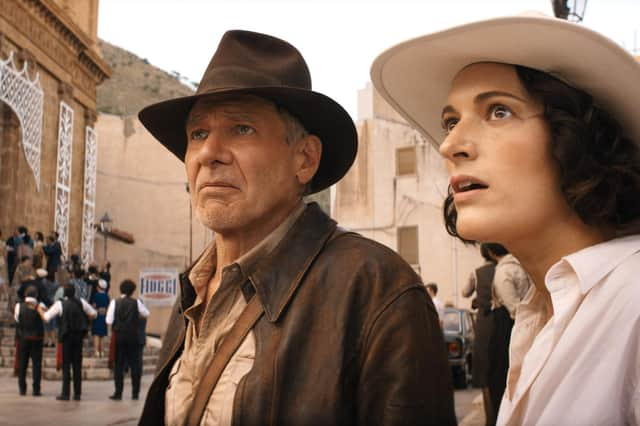Film review: Indiana Jones and the Dial of Destiny


Indiana Jones and the Dial of Destiny (12A) ***
Although it’s no real secret that the plot of Indiana Jones and the Dial of Destiny messes with time, watching Harrison Ford’s Benjamin Button-ed archeologist square off against Nazis in the opening scenes of this fifth instalment is so uncanny it briefly makes you wonder if its makers cut it together from some never-before-seen footage from 1989’s Indiana Jones and the Last Crusade. Initially rewinding the franchise clock back to 1944, the new film – the first not directed by Steven Spielberg or co-written by George Lucas – finds director James Mangold (Cop Land, Logan) doing his best to invoke the spirit of the first three by dropping Ford’s digitally de-aged Indy into World War II in pursuit of a sacred relic aboard a train full of stolen loot and soon-to-be-defeated Nazis.
The set-piece itself is a pastiche of a pastiche, with Mangold deploying this younger-looking Ford in a sly effort to re-establish the vibrancy of the series after the creaky, extraterrestrial shenanigans of previous instalment The Kingdom of the Crystal Skull. But if the extensive CGI required to pull it off is the antithesis of all those corner-cutting practical effects that Spielberg initially utilised to mimic the cheap Saturday morning adventure serials that inspired Indy’s creation, the irony isn’t lost on Mangold or his star. Introducing us to the titular MacGuffin, an ancient relic known as the Antikythera that supposedly has the power to locate “fissures in time”, the film’s lengthy opening salvo gives way to its own fissure in time by jumping forward to New York City in the age of the Moon landings to reveal the film’s best and most unadorned special effect — Ford playing Indiana Jones as he is now: a white-haired, cranky old man, the sort who shouts at his hippy neighbours for blasting out Beatles songs and whose lectures as the soon-to-retire Professor Jones no longer inspire eyelid-batting and swooning, just eye-rolling and yawning.
Advertisement
Hide AdThere’s a real poignancy to seeing Indy this way. Living by himself in a cramped New York apartment, divorce papers on his kitchen counter, it’s no longer just the mileage but the years that have taken their toll – and Ford is great at conveying the extent to which Indy has been displaced by the rapidly changing times without getting all mushy on us. Not that there’s any time for mushiness. The insistent tick-tick-tick of the clock that plays over the start of the movie is also something of a metronomic reminder for Mangold to keep things moving and within minutes of Indy’s reluctant retirement from New York’s Hunter college, two figures from his past plunge him into another death-defying adventure.
The first is Mads Mikkelsen’s entertainingly sinister Jürgen Voller, a German rocket scientist who’s just helped put the Americans on the Moon and is now using his government privileges to track down the Antikythera to revive his own thwarted Nazi dreams. The second is Indy’s goddaughter Helena Shaw (Phoebe Waller-Bridge), who’s after the Antikythera for her own roguish, ignoble ends and is convinced Indy has stashed it somewhere. The elaborate chase that follows spills out from the archives of Hunter College onto the streets of Manhattan, revealing the film’s other great special effect – the transformation of Glasgow into New York in the midst of a ticker tape parade celebrating the return of the Apollo 11 astronauts (anyone who spent any time wandering the sets will see the extreme attention to detail wasn’t wasted). As the CGI-augmented action jumps from street level to roof level to the New York City subway (with Indy on horseback), it’s as ridiculously fun as it is ridiculously implausible.
Thenceforth Indy (hat, whip and leather jacket now in place), travels to Tangiers, Athens and Sicily, his cantankerous relationship with Helena deepening as they hunt down a missing component of the Antikythera, which also keeps falling in and out of their possession. Other characters new and old (including Antonio Banderas as a veteran diver) enter the fray, though Waller-Bridge is by far the sparkiest addition, her character’s bickering banter with Indy mirroring Ford’s earlier pairing with Sean Connery – only with Indy now the disapproving father figure. There are plenty of other call-backs, mostly involving oversized insects and underground tombs and all of them accompanied by John Williams’ incomparable score (rumoured to be his last). Mercifully none of these are particularly egregious; on the contrary, they help keep the film on track, even as its increasingly silly finale starts hurtling into Crystal Skull territory.
As a final crack of the whip, though, there’s not too much to complain about. Moment to moment it’s perfectly enjoyable, but having grown up with these films, watching it is a strange experience. Time wise we’re as far away from 1981’s Raiders of the Lost Ark as that film was from the adventure serials it was riffing on. Yet for better or worse we’re still very much living in the blockbuster age it spawned: one of repeatedly exhumed IP, escalating set-pieces and apocalyptic events from which humanity needs constant saving. But the blockbuster spectacle isn’t really why Indiana Jones has endured for 42 years. He’s endured because of Ford and the small character moments that Spielberg smartly layered into that first film. And it’s those that Mangold honours with a final scene that brings things full circle to one of the quietest moments in Raiders, giving the man in the hat the gruffly tender send-off he deserves.
General release from 28 June